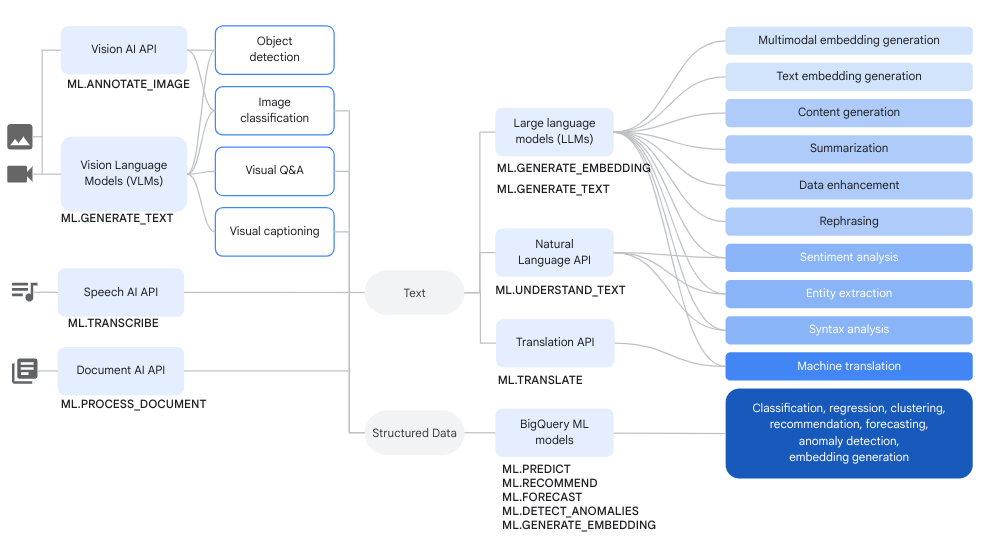AI application overview
This document describes the artificial intelligence (AI) application features that BigQuery ML supports. These features let you perform AI tasks in BigQuery ML by using Cloud AI APIs. Supported tasks include the following:
- Natural language processing
- Machine translation
- Audio transcription
- Document processing
- Computer vision
You access a Cloud AI API to perform one of these functions by creating a remote model in BigQuery ML that represents the API endpoint. Once you have created a remote model over the AI resource that you want to use, you access that resource's capabilities by running a BigQuery ML function against the remote model.
This approach lets you use the capabilities of the underlying API without having to know Python or develop familiarity with API.
Workflow
You can use remote models over Vertex AI models and remote models over Cloud AI services together with BigQuery ML functions in order to accomplish complex data analysis and generative AI tasks.
The following diagram shows some typical workflows where you might use these capabilities together:

Natural language processing
You can use natural language processing to perform tasks such as classification and sentiment analysis on your data. For example, you could analyze product feedback to estimate whether customers like a particular product.
To perform natural language tasks, you can create a reference to the
Cloud Natural Language API by creating a remote model and specifying
CLOUD_AI_NATURAL_LANGUAGE_V1 for the REMOTE_SERVICE_TYPE value. You can then use the
ML.UNDERSTAND_TEXT function
to interact with that service. ML.UNDERSTAND_TEXT works with data in
standard tables. All inference
occurs in Vertex AI. The results are stored in
BigQuery.
To learn more, try
understanding text with the ML.UNDERSTAND_TEXT function.
Machine translation
You can use machine translation to translate text data into other languages. For example, translating customer feedback from an unfamiliar language into a familiar one.
To perform machine translation tasks, you can create a reference to the
Cloud Translation API by creating a remote model and specifying
CLOUD_AI_TRANSLATE_V3 for the REMOTE_SERVICE_TYPE value. You can then use the
ML.TRANSLATE function
to interact with that service. ML.TRANSLATE works with data in
standard tables. All inference
occurs in Vertex AI. The results are stored in
BigQuery.
To learn more, try
translating text with the ML.TRANSLATE function.
Audio transcription
You can use audio transcription to transcribe audio files into written text. For example, transcribing a voicemail recording into a text message.
To perform audio transcription tasks, you can create a reference to the
Speech-to-Text API by creating a remote model and specifying
CLOUD_AI_SPEECH_TO_TEXT_V2 for the REMOTE_SERVICE_TYPE value. You can
optionally specify a recognizer to use to process the audio
content. You can then use the
ML.TRANSCRIBE function
to transcribe audio files. ML.TRANSCRIBE works with audio files in
object tables. All inference
occurs in Vertex AI. The results are stored in
BigQuery.
To learn more, try
transcribing audio files with the ML.TRANSCRIBE function.
Document processing
You can use document processing to extract insights from unstructured documents. For example, extracting relevant information from invoice files so it can be input into accounting software.
To perform document processing tasks, you can create a reference to the
Document AI API by creating a remote model,
specifying CLOUD_AI_DOCUMENT_V1 for the REMOTE_SERVICE_TYPE value, and
specifying a processor to use to process the
document content. You can then use the
ML.PROCESS_DOCUMENT function
to process documents. ML.PROCESS_DOCUMENT works on documents in
object tables. All inference
occurs in Vertex AI. The results are stored in
BigQuery.
To learn more, try
processing documents with the ML.PROCESS_DOCUMENT function.
Computer vision
You can use computer vision to perform image analysis tasks. For example, you could analyze images to detect whether they contain faces, or to generate labels describing the objects in the image.
To perform computer vision tasks, you can create a reference to the
Cloud Vision API by creating a remote model and
specifying CLOUD_AI_VISION_V1 for the REMOTE_SERVICE_TYPE value. You can then use the
ML.ANNOTATE_IMAGE function
to annotate images by using that service. ML.ANNOTATE_IMAGE works with data in
object tables. All inference
occurs in Vertex AI. The results are stored in
BigQuery.
To learn more, try
annotating object table images with the ML.ANNOTATE_IMAGE function.
What's next
- For more information about performing inference over machine learning models, see Model inference overview.
